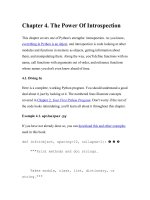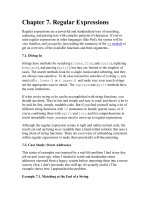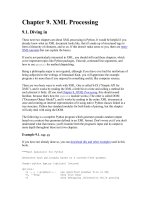Tài liệu Dive Into Python-Chapter 5. Objects and Object-Orientation ppt
Bạn đang xem bản rút gọn của tài liệu. Xem và tải ngay bản đầy đủ của tài liệu tại đây (580.56 KB, 32 trang )
Chapter 5. Objects and Object-Orientation
This chapter, and pretty much every chapter after this, deals with object-
oriented Python programming.
5.1. Diving In
Here is a complete, working Python program. Read the doc strings of
the module, the classes, and the functions to get an overview of what this
program does and how it works. As usual, don't worry about the stuff you
don't understand; that's what the rest of the chapter is for.
Example 5.1. fileinfo.py
If you have not already done so, you can download this and other examples
used in this book.
"""Framework for getting filetype-specific
metadata.
Instantiate appropriate class with filename.
Returned object acts like a
dictionary, with key-value pairs for each piece of
metadata.
import fileinfo
info =
fileinfo.MP3FileInfo("/music/ap/mahadeva.mp3")
print "\\n".join(["%s=%s" % (k, v) for k, v in
info.items()])
Or use listDirectory function to get info on all
files in a directory.
for info in
fileinfo.listDirectory("/music/ap/", [".mp3"]):
...
Framework can be extended by adding classes for
particular file types, e.g.
HTMLFileInfo, MPGFileInfo, DOCFileInfo. Each class
is completely responsible for
parsing its files appropriately; see MP3FileInfo
for example.
"""
import os
import sys
from UserDict import UserDict
def stripnulls(data):
"strip whitespace and nulls"
return data.replace("\00", "").strip()
class FileInfo(UserDict):
"store file metadata"
def __init__(self, filename=None):
UserDict.__init__(self)
self["name"] = filename
class MP3FileInfo(FileInfo):
"store ID3v1.0 MP3 tags"
tagDataMap = {"title" : ( 3, 33,
stripnulls),
"artist" : ( 33, 63,
stripnulls),
"album" : ( 63, 93,
stripnulls),
"year" : ( 93, 97,
stripnulls),
"comment" : ( 97, 126,
stripnulls),
"genre" : (127, 128, ord)}
def __parse(self, filename):
"parse ID3v1.0 tags from MP3 file"
self.clear()
try:
fsock = open(filename, "rb", 0)
try:
fsock.seek(-128, 2)
tagdata = fsock.read(128)
finally:
fsock.close()
if tagdata[:3] == "TAG":
for tag, (start, end, parseFunc) in
self.tagDataMap.items():
self[tag] =
parseFunc(tagdata[start:end])
except IOError:
pass
def __setitem__(self, key, item):
if key == "name" and item:
self.__parse(item)
FileInfo.__setitem__(self, key, item)
def listDirectory(directory, fileExtList):
"get list of file info objects for files of
particular extensions"
fileList = [os.path.normcase(f)
for f in os.listdir(directory)]
fileList = [os.path.join(directory, f)
for f in fileList
if os.path.splitext(f)[1] in
fileExtList]
def getFileInfoClass(filename,
module=sys.modules[FileInfo.__module__]):
"get file info class from filename
extension"
subclass = "%sFileInfo" %
os.path.splitext(filename)[1].upper()[1:]
return hasattr(module, subclass) and
getattr(module, subclass) or FileInfo
return [getFileInfoClass(f)(f) for f in
fileList]
if __name__ == "__main__":
for info in listDirectory("/music/_singles/",
[".mp3"]):
print "\n".join(["%s=%s" % (k, v) for k, v
in info.items()])
This program's output depends on the files on your hard drive. To get
meaningful output, you'll need to change the directory path to point to a
directory of MP3 files on your own machine.
This is the output I got on my machine. Your output will be different, unless,
by some startling coincidence, you share my exact taste in music.
album=
artist=Ghost in the Machine
title=A Time Long Forgotten (Concept
genre=31
name=/music/_singles/a_time_long_forgotten_con.mp3
year=1999
comment=
album=Rave Mix
artist=***DJ MARY-JANE***
title=HELLRAISER****Trance from Hell
genre=31
name=/music/_singles/hellraiser.mp3
year=2000
comment=
album=Rave Mix
artist=***DJ MARY-JANE***
title=KAIRO****THE BEST GOA
genre=31
name=/music/_singles/kairo.mp3
year=2000
comment=
album=Journeys
artist=Masters of Balance
title=Long Way Home
genre=31
name=/music/_singles/long_way_home1.mp3
year=2000
comment=
album=
artist=The Cynic Project
title=Sidewinder
genre=18
name=/music/_singles/sidewinder.mp3
year=2000
comment=
album=Digitosis@128k
artist=VXpanded
title=Spinning
genre=255
name=/music/_singles/spinning.mp3
year=2000
comment=
5.2. Importing Modules Using from module import
Python has two ways of importing modules. Both are useful, and you should
know when to use each. One way, import module, you've already seen
in Section 2.4, “Everything Is an Object”. The other way accomplishes the
same thing, but it has subtle and important differences.
Here is the basic from module import syntax:
from UserDict import UserDict
This is similar to the import module syntax that you know and love, but
with an important difference: the attributes and methods of the imported
module types are imported directly into the local namespace, so they are
available directly, without qualification by module name. You can import
individual items or use from module import * to import everything.
from module import * in Python is like use module in Perl;
import module in Python is like require module in Perl.
from module import * in Python is like import module.* in
Java; import module in Python is like import module in Java.
Example 5.2. import module vs. from module import
>>> import types
>>> types.FunctionType
<type 'function'>
>>> FunctionType
Traceback (innermost last):
File "<interactive input>", line 1, in ?
NameError: There is no variable named
'FunctionType'
>>> from types import FunctionType
>>> FunctionType
<type 'function'>
The types module contains no methods; it just has attributes for each
Python object type. Note that the attribute, FunctionType, must be
qualified by the module name, types.
FunctionType by itself has not been defined in this namespace; it
exists only in the context of types.
This syntax imports the attribute FunctionType from the types
module directly into the local namespace.
Now FunctionType can be accessed directly, without reference to
types.
When should you use from module import?
If you will be accessing attributes and methods often and don't want to
type the module name over and over, use from module import.
If you want to selectively import some attributes and methods but not
others, use from module import.
If the module contains attributes or functions with the same name as
ones in your module, you must use import module to avoid name
conflicts.
Other than that, it's just a matter of style, and you will see Python code
written both ways.
Use from module import * sparingly, because it makes it difficult
to determine where a particular function or attribute came from, and that
makes debugging and refactoring more difficult.
Further Reading on Module Importing Techniques
eff-bot has more to say on import module vs. from module
import.
Python Tutorial discusses advanced import techniques, including
from module import *.
5.3. Defining Classes
Python is fully object-oriented: you can define your own classes, inherit
from your own or built-in classes, and instantiate the classes you've defined.
Defining a class in Python is simple. As with functions, there is no separate
interface definition. Just define the class and start coding. A Python class
starts with the reserved word class, followed by the class name.
Technically, that's all that's required, since a class doesn't need to inherit
from any other class.
Example 5.3. The Simplest Python Class
class Loaf:
pass
The name of this class is Loaf, and it doesn't inherit from any other class.
Class names are usually capitalized, EachWordLikeThis, but this is
only a convention, not a requirement.
This class doesn't define any methods or attributes, but syntactically, there
needs to be something in the definition, so you use pass. This is a Python
reserved word that just means “move along, nothing to see here”. It's a
statement that does nothing, and it's a good placeholder when you're
stubbing out functions or classes.
You probably guessed this, but everything in a class is indented, just like
the code within a function, if statement, for loop, and so forth. The first
thing not indented is not in the class.
The pass statement in Python is like an empty set of braces ({}) in
Java or C.
Of course, realistically, most classes will be inherited from other classes, and
they will define their own class methods and attributes. But as you've just
seen, there is nothing that a class absolutely must have, other than a name. In
particular, C++ programmers may find it odd that Python classes don't have
explicit constructors and destructors. Python classes do have something
similar to a constructor: the __init__ method.
Example 5.4. Defining the FileInfo Class
from UserDict import UserDict
class FileInfo(UserDict):
In Python, the ancestor of a class is simply listed in parentheses
immediately after the class name. So the FileInfo class is inherited
from the UserDict class (which was imported from the UserDict
module). UserDict is a class that acts like a dictionary, allowing you to
essentially subclass the dictionary datatype and add your own behavior.
(There are similar classes UserList and UserString which allow
you to subclass lists and strings.) There is a bit of black magic behind this,
which you will demystify later in this chapter when you explore the
UserDict class in more depth.
In Python, the ancestor of a class is simply listed in parentheses
immediately after the class name. There is no special keyword like
extends in Java.
Python supports multiple inheritance. In the parentheses following the class
name, you can list as many ancestor classes as you like, separated by
commas.
5.3.1. Initializing and Coding Classes
This example shows the initialization of the FileInfo class using the
__init__ method.
Example 5.5. Initializing the FileInfo Class
class FileInfo(UserDict):
"store file metadata"
def __init__(self, filename=None):
Classes can (and should) have doc strings too, just like modules and
functions.
__init__ is called immediately after an instance of the class is created.
It would be tempting but incorrect to call this the constructor of the class.
It's tempting, because it looks like a constructor (by convention,
__init__ is the first method defined for the class), acts like one (it's
the first piece of code executed in a newly created instance of the class),
and even sounds like one (“init” certainly suggests a constructor-ish
nature). Incorrect, because the object has already been constructed by the
time __init__ is called, and you already have a valid reference to the
new instance of the class. But __init__ is the closest thing you're
going to get to a constructor in Python, and it fills much the same role.
The first argument of every class method, including __init__, is
always a reference to the current instance of the class. By convention, this
argument is always named self. In the __init__ method, self
refers to the newly created object; in other class methods, it refers to the
instance whose method was called. Although you need to specify self
explicitly when defining the method, you do not specify it when calling
the method; Python will add it for you automatically.
__init__ methods can take any number of arguments, and just like
functions, the arguments can be defined with default values, making them
optional to the caller. In this case, filename has a default value of
None, which is the Python null value.
By convention, the first argument of any Python class method (the
reference to the current instance) is called self. This argument fills the
role of the reserved word this in C++ or Java, but self is not a
reserved word in Python, merely a naming convention. Nonetheless,
please don't call it anything but self; this is a very strong convention.
Example 5.6. Coding the FileInfo Class
class FileInfo(UserDict):
"store file metadata"
def __init__(self, filename=None):
UserDict.__init__(self)
self["name"] = filename
Some pseudo-object-oriented languages like Powerbuilder have a concept
of “extending” constructors and other events, where the ancestor's method
is called automatically before the descendant's method is executed. Python
does not do this; you must always explicitly call the appropriate method in
the ancestor class.
I told you that this class acts like a dictionary, and here is the first sign of
it. You're assigning the argument filename as the value of this object's
name key.
Note that the __init__ method never returns a value.
5.3.2. Knowing When to Use self and __init__
When defining your class methods, you must explicitly list self as the first
argument for each method, including __init__. When you call a method
of an ancestor class from within your class, you must include the self
argument. But when you call your class method from outside, you do not
specify anything for the self argument; you skip it entirely, and Python
automatically adds the instance reference for you. I am aware that this is
confusing at first; it's not really inconsistent, but it may appear inconsistent
because it relies on a distinction (between bound and unbound methods) that
you don't know about yet.
Whew. I realize that's a lot to absorb, but you'll get the hang of it. All Python
classes work the same way, so once you learn one, you've learned them all.
If you forget everything else, remember this one thing, because I promise it
will trip you up:
__init__ methods are optional, but when you define one, you must
remember to explicitly call the ancestor's __init__ method (if it
defines one). This is more generally true: whenever a descendant wants
to extend the behavior of the ancestor, the descendant method must
explicitly call the ancestor method at the proper time, with the proper
arguments.
Further Reading on Python Classes
Learning to Program has a gentler introduction to classes.
How to Think Like a Computer Scientist shows how to use classes to
model compound datatypes.
Python Tutorial has an in-depth look at classes, namespaces, and
inheritance.
Python Knowledge Base answers common questions about classes.
5.4. Instantiating Classes
Instantiating classes in Python is straightforward. To instantiate a class,
simply call the class as if it were a function, passing the arguments that the
__init__ method defines. The return value will be the newly created
object.
Example 5.7. Creating a FileInfo Instance
>>> import fileinfo
>>> f =
fileinfo.FileInfo("/music/_singles/kairo.mp3")









